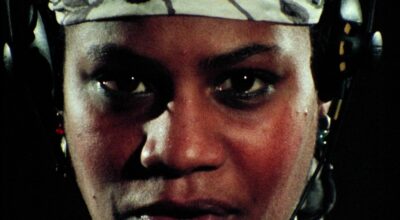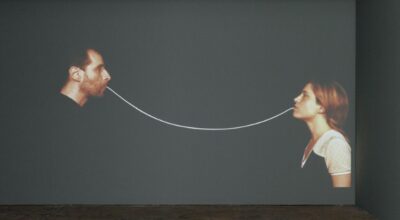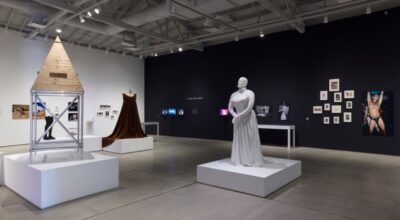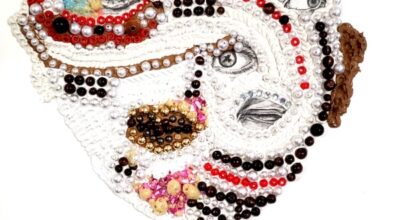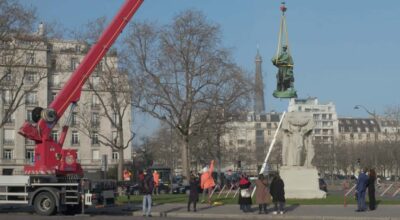English
BORN IN FLAMES: FEMINIST FUTURES
“Born in Flames” highlights a number of artists referencing non-Western folklore and mythologies to create alternate futures. Their works are representative of how each artist is thinking about futurism––including Afro-, Asian-, Indigenous-, and Latinx-futurism, or something that emerges from those narratives.
HELLEN ASCOLI: CIEN TIERRAS
“Each weave is intimately related to the body it harnesses,” the artist writes. “Its warp is the width of my hips, its length mirrors my height, its designs are spaced by the threads I can hold in my hand… It carries memory through touch, a proximity sense. I choose to use materials that reveal vestiges of bodies that were once there.”
ANNA MARIA MAIOLINO: IN THE SKY I AM ONE AND MANY AND AS A HUMAN I AM EVERYTHING AND NOTHING
Anna Maria Maiolino (b. 1942) is one of the most significant women artists working in Brazil today. The Italian-born Brazilian artist’s first institutional solo exhibition in Switzerland, at Kunsthaus Baselland, features a selection of her early videos, films, photographs, poems, and texts, spanning a narrative arc through her artistic work and life from the 1970s to the present. She converses here with curator and Art Historian Ines Goldbach.
QUEER COMMUNION: RON ATHEY
As one of the most generative and important performance artists to emerge in the twentieth century, Athey challenges traditional limits of artistic practice—activating the body as a site of trauma, resistance, sexuality, and religious ecstacy. The artist, who has been HIV positive since the mid-1980s, explores pain, fetishism, power, and queer politics, commenting on the intersections and synergies among Christian fundamentalist religious traditions and ritual, through highly visceral performances and interventions
JORGE SATORRE: BLACK JACKET, GRAY SWEATSHIRT
Satorre connects the interior of the art center, protected by its thick defensive walls, and the exterior, a garden that runs alongside. “Most of the works included in this exhibition at CRAC Alsace were developed on site, intuitively responding to the characteristics of the space and its surroundings. The formal core of the proposal consists in connecting the interior of the building both physically and conceptually to the garden behind it”, says the artist.
RADICAL EMPATHIES
The exhibition «Radical Empathies» focuses on the intersection of feminism and ecology featuring artists from Guatemala where authoritarian regimes as well as western interventionism have brutally inscribed their politics on all bodies: human, animal, plant and celestial. These bodies, vulnerable, unstable and transient deflect fixed notions of violence and provide a space of resistance and resilience
HILOS
«Hilos» is a response to the way craft is framed within Western institutions displaying Latin American, Indigenous and Caribbean Art. Historically these works are shown within a “primitive” lens of the past, and disregard the continuous ripples of colonization that have been woven into the fabric of Latinx identity and history.
RODRIGO VALENZUELA: NEW WORKS FOR A POST-WORKER’S WORLD
In their invocation of histories of labor, and of industries created by humans in order to displace themselves in the service of capital, these photographs intersect with the struggles for unionization, a longtime interest for Valenzuela. They stress the body’s worth—both single and collective—as well as that of rest and pleasure.
IVÁN ARGOTE: A PLACE FOR US
For the last 15 years, Iván Argote has been investigating and creating interventions on public monuments from his home country of Colombia to his current home in France. Influenced by the 2020 global uprisings of a new generation of young social activists confronting systems of inequality, oppression, and racial hierarchy, Argote’s artistic works come through as poetic and political gestures. At Perrotin, he presents six new series that propose alternatives for contested monuments within major historic cities.
ONE YEAR OF DIGITAL EXHIBITIONS: FOUR EXPERIENCES
Since we all are possibly facing an extended period of closures due to new outbreaks, digital exhibitions continue to connect us across continents and as such they are a worthy medium to examine critically. For my overview of four shows, I draw on the concept of “mise-en-scène”, the way digital artworks are presented, as recently elaborated on by one of the major research platforms of digital art, Rhizome.

